Line 6 POD xt Pro, TonePort UX2, TonePort UX8, TonePort GX, TonePort KB37 User Manual
...
v3.5 User Guide
Getting Started WithYour Hardware
GX UX1 UX2 KB37 DI UX8
Guitar |
PODxt |
PODxt |
PODxt |
|
Port |
Live |
Pro |
||
|
GearBox Basics
Stand-alone
Application
Online Help Recording & More
Step by Step Recording Setups, Installation,Troubleshooting and more
Plug-In
Store |
Support |
Model |
Online |
Packs & |
Support |
Plug-In |
Pages |
Top Issues
•Important! Connect speakers or headphones to Line 6 hardware, not directly to computer. Click on the “Getting Started” links above for more details.
•USB Required: Line 6 hardware must be connected via USB to use GearBox Plug-In
•Hear computer’s soundcard and GearBox sound through the same speakers
•Hooking up to a guitar amplifier
•Setting up ToneDirect™ Monitoring with GearBox Plug-In
Table of Contents
Start Here................................................................................................. |
1•1 |
Activation....................................................................................................................... |
1•1 |
Transferring Activations................................................................................................. |
1•1 |
About Line 6 Hardware & Software............................................................................... |
1•3 |
Before You Get Started................................................................................................... |
1•3 |
System Requirements and Installation........................................................................... |
1•3 |
Updating & Registering with Line 6 Monkey................................................................ |
1•3 |
Login account.................................................................................................................. |
1•3 |
Register your hardware.................................................................................................... |
1•3 |
Compatibility Check....................................................................................................... |
1•3 |
UsingYour Line 6 Hardware.................................................................... |
2•1 |
TonePort UX1................................................................................................................. |
2•1 |
TonePort UX2................................................................................................................. |
2•3 |
TonePort UX8................................................................................................................. |
2•6 |
TonePort KB37.............................................................................................................. |
2•11 |
TonePort DI................................................................................................................... |
2•13 |
TonePort GX................................................................................................................. |
2•15 |
GuitarPort...................................................................................................................... |
2•16 |
PODxt............................................................................................................................ |
2•17 |
PODxt Live................................................................................................................... |
2•18 |
PODxt PRO................................................................................................................... |
2•19 |
PODxt - Audio Signal Routing & Re-Amping............................................................ |
2•21 |
Routing audio from your Line 6 hardware to an external device................................. |
2•22 |
Connecting analog outputs to an external device ....................................................... |
2•22 |
Routing analog outputs to another sound card............................................................. |
2•23 |
Connecting the Digital Output from TonePort UX2, UX8, KB37 or |
|
PODxt Pro to an external digital device ...................................................................... |
2•23 |
ToneDirect™ Monitoring............................................................................................. |
2•23 |
Sound Cards & Sound Issues........................................................................................ |
2•26 |
Line 6 Driver Panel & Recording............................................................ |
3•1 |
Audio Routing................................................................................................................. |
3•1 |
The Line 6 Audio-MIDI Device Control Panel............................................................. |
3•2 |
Important Things to Know When Recording............................................................... |
3•24 |
GearBox Stand-alone Application.......................................................... |
4•1 |
Overview......................................................................................................................... |
4•1 |
GearBox Controls and Operation................................................................................... |
4•1 |
ii
Pre/Post Record Send...................................................................................................... |
4•6 |
Monitoring a GearBox-processed tone while recording “Dry”....................................... |
4•7 |
Dual-Tone operation (TonePort UX1/UX2/UX8/KB37)............................................... |
4•8 |
MIDI Control.................................................................................................................. |
4•9 |
TonePort UX2/UX8/KB37 Controllers......................................................................... |
4•10 |
KB37 Controllers........................................................................................................... |
4•10 |
GearBox with PODxt.................................................................................................... |
4•13 |
GearBox Controls and Operation................................................................................. |
4•13 |
PODxt MIDI control..................................................................................................... |
4•14 |
How To.......................................................................................................................... |
4•15 |
GearBox Plug-In....................................................................................... |
5•1 |
A Quickie Plug-in Primer............................................................................................... |
5•1 |
Activating the GearBox Plug-in..................................................................................... |
5•2 |
GearBox Plug-in Controls and Operation...................................................................... |
5•5 |
Where can I find the GearBox Plug-in on my computer?.............................................. |
5•6 |
Model Gallery........................................................................................... |
6•1 |
Guitar Amp & Cab Models............................................................................................ |
6•3 |
Bass Amp & Cab Models.............................................................................................. |
6•11 |
Preamp Models.............................................................................................................. |
6•13 |
Effects............................................................................................................................ |
6•15 |
Model List...................................................................................................................... |
6•23 |
Troubleshooting........................................................................................ |
7•1 |
What Is…..................................................................................................8•1 |
|
Online Help & Support............................................................................ |
9•1 |
Line 6, PODxt, PODxt Pro, TonePort, GearBox, ToneDirect Monitoring, GuitarPort, Line 6 Edit and Custom Tone are trademarks of Line 6, Inc. All other product names, trademarks, and artists’ names are the property of their respective owners, which are in no way associated or affiliated with Line 6.
© 2007 Line 6, Inc.
iii

Line 6 GearBox 3.5 – Start Here
Start Here
Activation
Some features of GearBox require “activation” using Line 6 Monkey and your Internet connection. Activation turns these features on in your GearBox-compatible hardware, so they can operate in the GearBox stand-alone application and Plug-in. “Monkey, you say?” – get the skinny on Line 6 Monkey here.
Detailed information on activating GearBox Plug-In can be found here.
Model Packs that you purchase from www.line6.com/store also need to be activated. You’ll find instructions on just how to do that here.
You may also transfer your activations to another computer with or without Internet access. The next section describes the process in detail.
Transferring Activations
So you just upgraded your computer to the latest and greatest (this week anyway…) model, and want to move GearBox to your new system? In this section, we’ll explain how to make the transfer process as easy as A-B-C, whether the new computer can connect to the internet or not.
The destination computer has an Internet connection
This is the easiest scenario: Download and install the GearBox application (always available at line6. com/software). This will also install the necessary drivers for your hardware and the Line 6 Monkey application.
GearBox Plug-in doesn’t work!!! Where are my Model Packs??? Relax –Your Add-Ons (Model Packs, Plug-in, etc…) are tied-in to your hardware’s ESN, but also need to be authorized with each new computer you’ll be using GearBox on. In other words, they work but just haven’t been enabled on the new computer yet.
Launch Line 6 Monkey. The Monkey utility will connect to the server and scan your hardware for any activated Add-ons, and if it finds any, will display the following message:
1•1
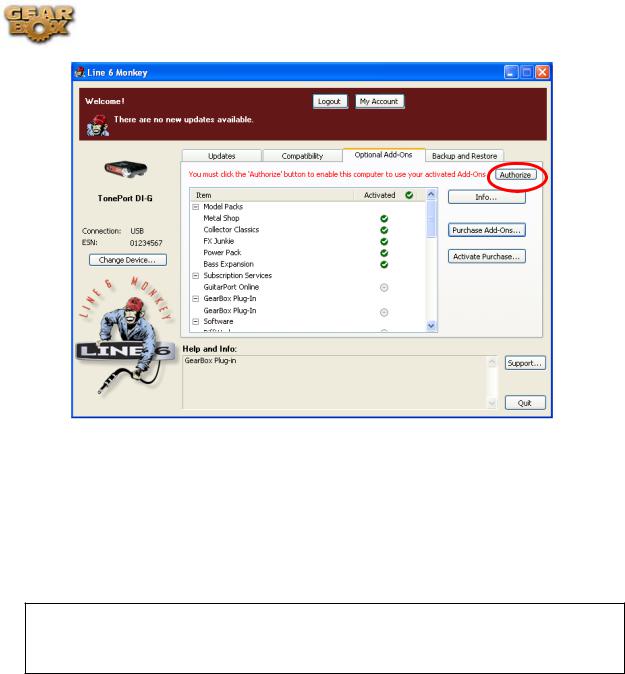
Line 6 GearBox 3.5 – Start Here
Just click Authorize, and Monkey will enable the use of your activated Add-On(s) on the new computer system.
The destination computer lacks an Internet connection
So you just got the call from Mr. Big Time Producer for a session at so-and-so’s studio, and you want to bring all this great Line 6 tone along for tracking – but their computer does not connect to the internet. You can still move your GearBox activation to their recording environment by following these steps:
Prerequisite: This may seem obvious but we’ll mention it anyway: Your hardware and all GearBox Software and Add-ons must already be activated and authorized on your own computer (meaning, an Internet connection is required and has been used for the initial activation of your GearBox assets).
On your computer:
•Locate and copy all .aet files to removable media (CD, Flash drive, etc…). In Windows® environments, these files can be found in the C:\Document_and_Settings\(username)\ Application Data\Line 6\GuitarPort folder; on Mac®, look in /Users/(username)/Library/ Application Support/Line 6/GuitarPort.
•Copy the GearBox installer to removable media, since the destination computer will not be able to download it.
On the destination computer:
•Install the GearBox software.
•Copy the .aet files from your removable storage into the correct folder (described above). You may have to create this folder manually if it isn’t present.
1•2

Line 6 GearBox 3.5 – Start Here
You’re done! You should now be able to launch the GearBox application with all Add-Ons enabled. Just remember that for Plug-in operation, your Line 6 hardware must always be connected via USB (even if you’re using a 3rd-party interface).
About Line 6 Hardware & Software
BeforeYou Get Started
OK, you’ve got your guitar, a computer and a head full of songs and cool licks, so how do you get this all going? You’re just a few steps away from turning your computer into a serious Tone, jamming and recording machine. First, here is some valuable information to ensure you have all the latest and greatest updates….
System Requirements and Installation
If you need to check the system requirements or some assistance with installing GearBox on your Windows or Mac computer, please refer to the separate documents located on the GearBox Online Help page of the Line 6 website.
Updating & Registering with Line 6 Monkey
Line 6 Monkey is the intelligent updater utility that is automatically installed with your GearBox application. You are prompted to run Line 6 Monkey at the end of your GearBox installation, but it’s a great idea to do this often so you can be sure you have all the latest updates for all your Line 6 software and hardware products. Registering your Line 6 hardware is also very important because it ensures that you’re dialed in for warranty service and makes it possible for us to contact you if new software versions or other cool enhancements are offered - cutting edge technology and such! So don’t put this off any longer. Connect your Line 6 hardware to your computer and follow these steps to launch Line
6Monkey...
•On Mac®, go to Applications - Line 6.
•On Windows®, go to Start - Programs - Line 6 - Tools.
Login account
You’ll need to Login so that Line 6 Monkey can communicate with the online Line 6 Server and provide you with exactly what you need. It’s just a few clicks, and it’s free!
•If you have a Line 6 account, then type in your User Name and Password at the top of the Monkey dialog.
•If you have not yet created an account, click the New User button and you’ll be walked right through the steps.
Register your hardware
If you have not already done so, you’ll be prompted to Register your connected Line 6 hardware. It’s a painless process really, so click that Register Now button and fill in the blanks on the Web page. This page will list all your registered Line 6 gear in one place.
Compatibility Check
To check your Mac® or Windows® computer system to see if it meets the requirements to run GearBox, launch Line 6 Monkey and go to the Compatibility tab:
1•3
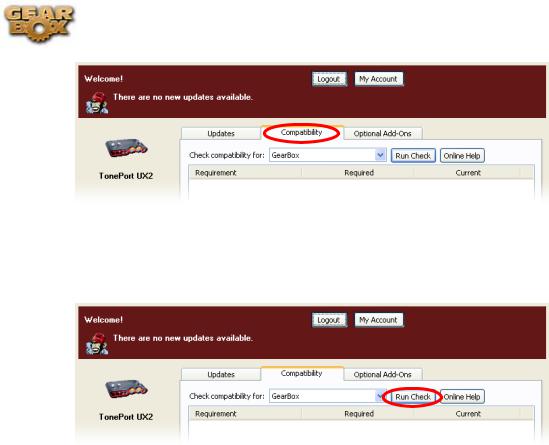
Line 6 GearBox 3.5 – Start Here
Just click the Run Check button and Monkey will check your system and list a report of all items in the window, letting you know if they pass the minimum requirements needed for GearBox.
For a complete list of GearBox system requirements, please see the GearBox 2 Release Notes document on the GearBox Online Help page of the Line 6 website.
1•4
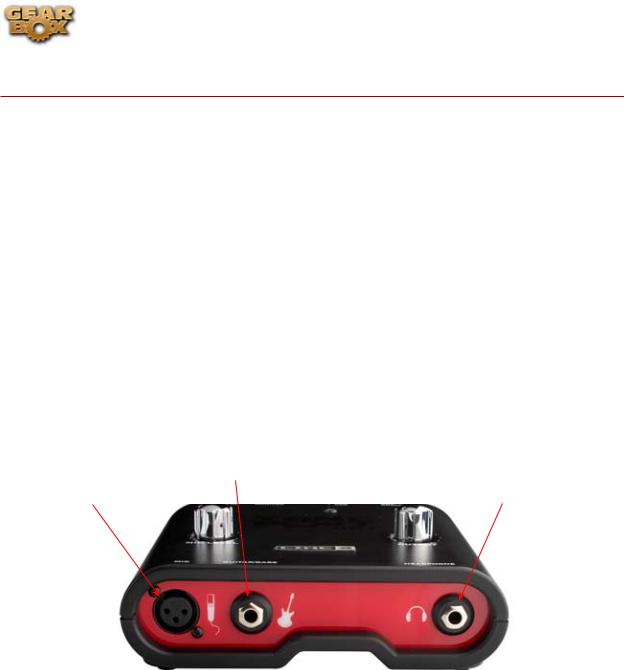
Line 6 GearBox 3.5 – UsingYour Line 6 Hardware
Using Your Line 6 Hardware
The GearBox 3 software is designed to work with your Line 6 TonePort GX, DI, UX1, UX2, UX8, KB37, GuitarPort, PODxt, PODxt Live or PODxt Pro hardware. Your Line 6 device, since it connects to your computer via USB and utilizes the high-performance Line 6 Audio & MIDI drivers, it is easily configured to work as your computer’s sound card. This means that you can access all your Tones coming out of GearBox directly from most any audio recording application, all at the highest quality! But you are of course not just limited to using your Line 6 hardware to record into your computer – the outputs provided on the back of your device additionally allow you to feed your GearBox signal to external tape machines, DAT recorders, PA systems, or whatever else will accept an analog line level signal. Additionally, TonePort UX2, UX8 and PODxt Pro devices include a digital S/PDIF output to allow you to make these connections digitally!
There are some differences in the setup and functionality between the supported Line 6 devices, so be sure to look for the instructions in the following sections for your specific device. Primarily, TonePort and GuitarPort devices function quite similarly since all the Digital Signal Processing (DSP) is performed on your computer when using these units. PODxt devices do all their DSP magic inside the PODxt itself. Using the GearBox software is pretty similar for all these devices once you have everything setup. So here we go…
TonePort UX1
|
Connect your electric guitar or bass |
Connect a microphone |
Connect your stereo headphones |
Mic - To input a signal from a microphone, connect it here using an XLR cable. This inputs the microphone signal into GearBox where you can choose your tone, and then route the processed signal both to your audio software and out the TonePort outputs.
Guitar/Bass - To input your electric guitar or bass, plug it in here using a standard 1/4-inch TS instrument cable. This inputs the instrument’s signal into GearBox where you can then choose your tone and route the processed signal both to your audio software and out the TonePort outputs.
Phones - If you want to listen to the audio from TonePort using stereo headphones, then plug them into this 1/4-inch stereo jack. This headphone jack outputs the same signal fed to the Analog Outs on the rear panel of TonePort; the audio from your audio software on the computer, as well as anything plugged into any TonePort input.
2•1
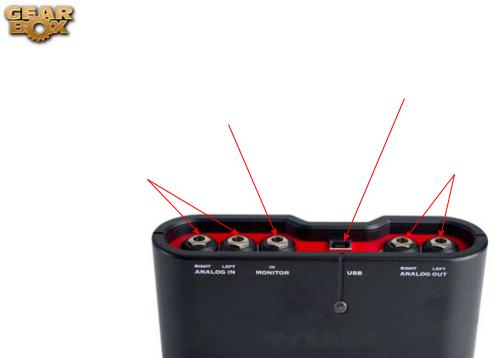
Line 6 GearBox 3.5 – UsingYour Line 6 Hardware
Connect any line level input source for monitoring to the Stereo Monitor In
Connect any line level input source that you want to record into the Line Inputs
Connect a USB cable from here to your computer’s USB port.*
Connect the Analog Outs to your audio monitors
*Note – be sure to always power off or mute your speakers or monitoring setup before connecting and disconnecting the USB cable between TonePort and your computer, as well as before booting up or shutting down your computer if TonePort is already connected. The best practice is to always power on your speakers last, and power them off first when connected to other audio gear to avoid a “pop”.
Line Inputs - To record the signal from a line level source, such as a keyboard, your stereo receiver, the line out from a mixing console, etc., connect them to these Left and Right ins using 1/4-inch TS audio cables.
Monitor In - If you want to hear the signal from a line level source along with all the other audio coming from your computer, but do not want this audio recorded, then plug the source in here. Note that this is a stereo jack, so you should use a stereo 1/4-inch TRS audio cable for this connection.
USB - This of course is where you connect the supplied USB cable to TonePort, with the other end going to your computer’s USB port. Note that you should always connect to a separate USB controller channel from other USB audio or MIDI interfaces to provide TonePort with the full USB bandwidth. TonePort also gets its power from this USB connection, so it should not be plugged into a non-powered USB hub, or operated on the same USB controller channel with un-powered devices. It is also recommended to connect directly into a USB port on your computer and not into a USB hub.
Analog Outs - These Left and Right unbalanced jacks output all the audio from TonePort; the audio from your audio software on the computer, and anything plugged into any TonePort input. These are what you want to connect to your powered speakers or monitoring system for a recording setup. Use 1/4-inch TS cables to connect directly to powered speakers, mixer or power amp setup. Note that you can also use the headphone jack on the front of TonePort if you want to use headphones for monitoring.
2•2
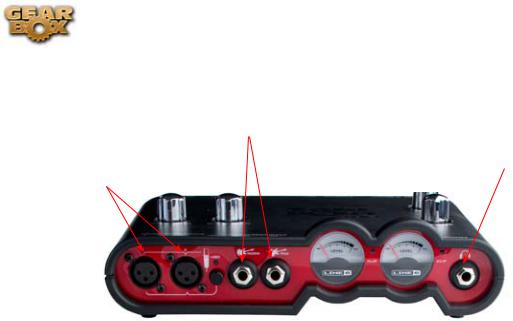
Line 6 GearBox 3.5 – UsingYour Line 6 Hardware
TonePort UX2
Connect your electric Guitar or Bass |
|
Connect up to two |
Connect your stereo |
Headphones |
|
Microphones |
|
Microphone Inputs - You can receive input from one or two mics at the same time using these ins. There is also a +48V Phantom Power switch that you should toggle to “on” if your mic requires phantom power (most condenser type mics do, but check the documentation for your mic if you are not sure). Connect each mic using an XLR cable. This inputs each microphone signal independently into GearBox where you can choose your tone, and then route the processed signal both to your audio software and out the TonePort outputs.
Guitar/Bass Inputs -To input your electric guitar or bass, plug it into one of these inputs. Either of these routes the instrument’s signal into GearBox where you can choose your tone and route the processed signal both to your audio software and out the TonePort outputs.
Norm – this input is for a standard instrument level output. Plug your guitar/bass into here using a standard 1/4-inch TS instrument cable.
Pad - this input is designed for high output level basses and guitars, especially those with active pickups. Plug your high output instrument into here using a standard 1/4-inch TS instrument cable.
Headphone - If you want to listen to the audio from TonePort using stereo headphones, then plug them into this 1/4-inch stereo jack. This Headphone jack outputs the same signal fed to the Analog Outs on the rear panel of TonePort; the audio from your audio software on the computer, as well as anything plugged into any TonePort input.
2•3
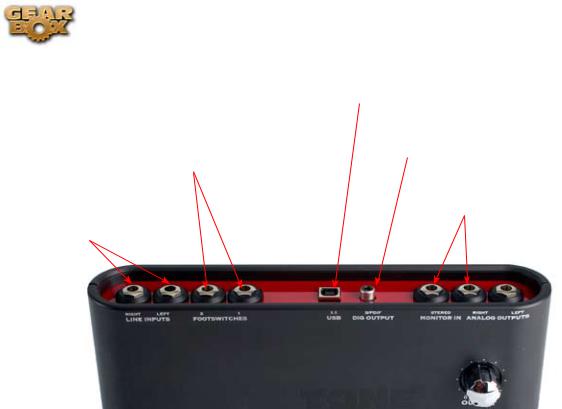
|
Line 6 GearBox 3.5 – UsingYour Line 6 Hardware |
||
|
Connect your USB cable |
||
|
from your computer’s USB |
||
|
port* |
Connect to the S/PDIF input of an |
|
Connect up to two standard toggle or momentary |
|||
external device to send TonePort’s |
|||
pedal switches into the Footswitches jacks for remote |
|||
output digitally |
|||
control of GearBox and audio application functions |
|||
|
|||
|
|
Connect any line level input |
|
Connect any line level |
|
source for monitoring to the |
|
input source that you want |
|
Stereo Monitor In |
|
to record into the Line |
|
Connect the Analog |
|
Inputs |
|
Outs to your audio |
|
monitors
*Note – be sure to always power off or mute your speakers or monitoring setup before connecting and disconnecting the USB cable between TonePort and your computer, as well as before booting up or shutting down your computer if TonePort is already connected. The best practice is to always power on your speakers last, and power them off first when connected to other audio gear to avoid a “pop”.
Line Inputs - if you want to record the signal from a line level source, such as a keyboard, your stereo receiver, the line out from a mixing console, etc., connect them to these Left and Right ins using 1/4- inch TS audio cables.
Footswitches - if you want to use one or two on/off toggle or momentary footswitches to remotely control functions in the GearBox software, you can plug the 1/4-inch footswitch plugs into these 1 and 2 jacks. To configure each Footswitch, go to the GearBox Preferences. For TonePort UX1, UX2, and KB37, you can also use these footswitches to trigger recording and playback commands within the included Ableton Live Lite software!
USB - This of course is where you connect the supplied USB cable to TonePort, with the other end going to your computer’s USB port. Note that you should always connect to a separate USB controller channel from other USB audio or MIDI interfaces to provide TonePort with the full USB bandwidth. TonePort also gets its power from this USB connection, so it should not be plugged into a non-powered USB hub, or operated on the same USB controller channel with un-powered devices. It is also recommended to connect directly into a USB port on your computer and not into a USB hub.
S/PDIF Digital Out - To send the output of TonePort to an external device digitally, connect a 75Ohm coaxial cable into this RCA jack and then into the S/PDIF digital input on the external device. This is the best choice for connecting to digital recording devices, such as a DAT recorder. This S/ PDIF output sends the same audio as is sent to TonePort’s Analog Outs* (with the exception that any audio coming into the TonePort’s Monitor In jack is not routed to the S/PDIF output). The digital signal is always sent at 24-bit resolution.
2•4

Line 6 GearBox 3.5 – UsingYour Line 6 Hardware
Monitor In - If you want to hear the signal from a line level source mixed with all the other audio coming from your computer, but do not want this audio recorded, then plug the source in here. Note that this is a stereo jack, so you should use a stereo 1/4-inch TRS audio cable for this connection.
Analog Outs - These Left and Right balanced jacks output all the audio from TonePort; the audio from your audio software on the computer, and anything plugged into any TonePort input. So, these are what you want to connect to your monitoring system when using TonePort as your computer’s sound card. Use either 1/4-inch TS or TRS cables to connect directly to your powered speakers, mixer or power amp setup. Note that you can also use the headphone jack on the front of TonePort if you want to use headphones for monitoring.
2•5
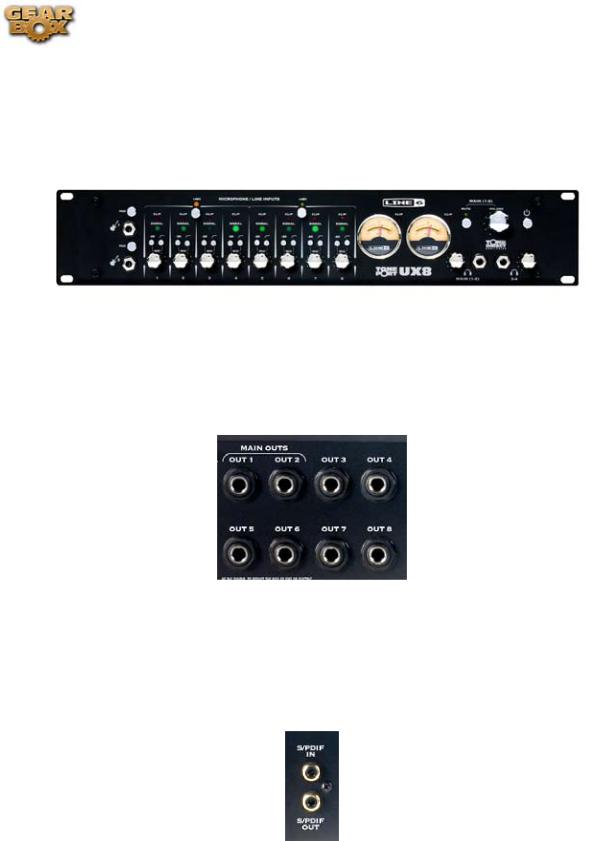
Line 6 GearBox 3.5 – UsingYour Line 6 Hardware
TonePort UX8
The TonePort UX8 is a multichannel recording interface designed for professional use, offering plenty of headroom, a wide dynamic range and an exceedingly low noise floor. Designed with high quality electrical components and a rugged exterior, the UX8 is built to provide many years of reliability.
Included with the UX8 is the GearBox Plug-In, providing all your tracks with same POD quality tone trusted by scores of platinum-selling musicians and recording engineers. In addition, the GearBox standalone application provides a virtual front end for professional tone processing.
Rear Panel Features
Balanced Outputs
TonePort UX8 provides 8 balanced analog outputs (4 stereo pairs). For the cleanest audio signal, use 1/4-inch TRS cables to connect directly to your powered speakers, mixer or power amp setup.
Note that you can use each output pair to provide different monitor mixes for musicians during a tracking session. You can set the input mix levels for each output pair using the Line 6 Audio-MIDI Devices application.
S/PDIF Digital Audio
To send or receive S/PDIF, connect a 75-Ohm coaxial cable to the UX8’s RCA jack and the external S/PDIF device. This is the best choice for connecting to digital recording devices, such as a DAT recorder. This S/PDIF output sends the same audio as Main Outs 1-2. The digital signal is always sent at 24 bit.
2•6
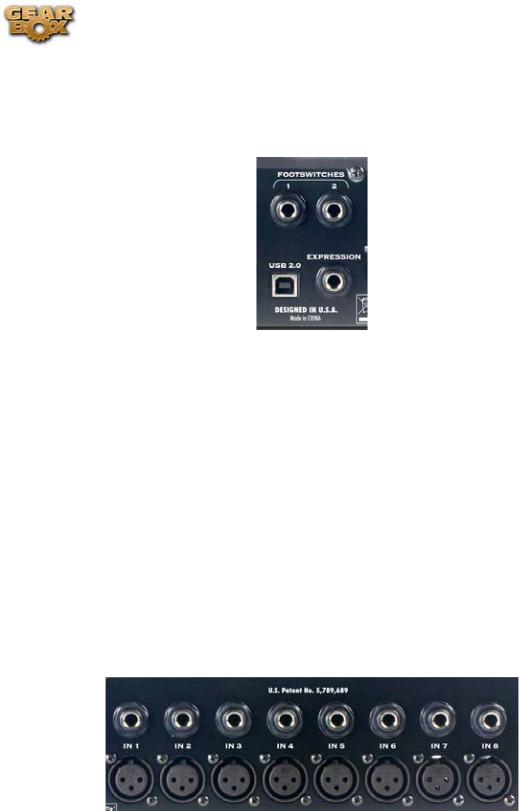
Line 6 GearBox 3.5 – UsingYour Line 6 Hardware
To sync to an external S/PDIF device, set the UX8 to sync to S/PDIF in the Line 6 Audio-MIDI Devices application.
Footswitch and Expression Pedal Jacks
You can use up to 2 on/off toggle or momentary footswitches, and 1 expression pedal to remotely control functions in the GearBox software, such as stomp effects or wah level. You can also configure footswitches and the expression pedal to send MIDI commands, which can be useful for controlling your recording software’s transport.
To configure footswitch and expression assignments, go to the Line 6 Audio-MIDI Devices application, MIDI tab.
USB 2.0
This of course is where you connect the supplied USB cable to TonePort, with the other end going to one of your computer’s USB ports. Note that you should always connect to a separate USB controller channel from other USB audio or MIDI interfaces to provide TonePort with the full USB bandwidth. It is also recommended to connect directly into a USB port on your computer and not into a USB hub.
Line Level and XLR Inputs
8 unbalanced line level inputs are available for recording line level sources, such as a keyboard, stereo receiver, the line out from a mixing console, etc. Connect to line level inputs using 1/4-inch TS audio cables.
2•7
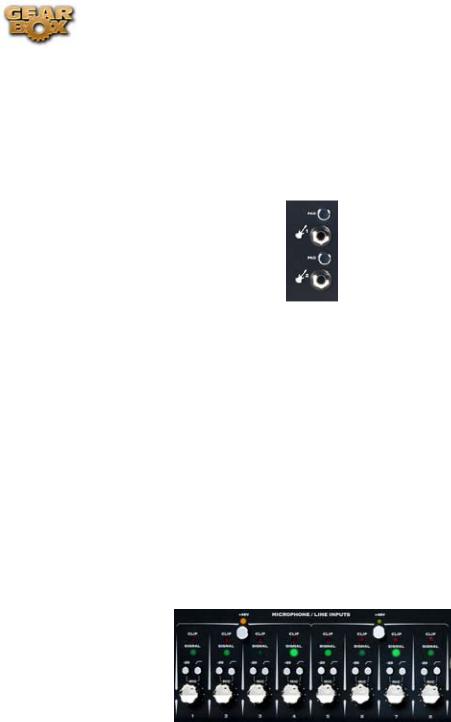
Line 6 GearBox 3.5 – UsingYour Line 6 Hardware
8 XLR preamp inputs are provided for balanced and mic input sources. +48 V Phantom Power switches are located on the front panel for mics requiring phantom power (most condenser type mics do, but check the documentation for your mic if you are not sure). Connect to these inputs using XLR cables.
Front Panel Features
Guitar/Bass Inputs
High-Z instrument inputs for guitar and bass are conveniently located on the front panel, providing convenient access for fast instrument switching.
-20 dB pad switches provide attenuation for hot levels, typically for instruments with onboard preamps or active pickups.
The TonePort UX8’s instrument inputs work directly with the GearBox standalone application to provide ToneDirect™ Monitoring, which provides a fully processed signal with ultra-low latency, critical for tracking with the desired sound.
Note that the processed signal from GearBox will show up in your recording application as additional sends to analog inputs 1 – 8. You can simultaneously record the direct, unprocessed signal (i.e. Input 1-2) for later processing using the included GearBox Plug-In.
For more information on using the GearBox standalone application, see GearBox (Full Program). For more information on using the GearBox Plug-In, see GearBox Plug-in.
Microphone Input Controls
Rear panel XLR input levels are controlled by a row of trim knobs on the front panel. Use these inputs for microphones or balanced input signals with a gain range of 0 dB to 45 dB.
Each XLR input has a -20 dB pad switch, which can be used to provide more headroom for high output microphones. A 75 Hz cutoff switch is also provided, useful for eliminating low frequency rumble from microphone sources.
Two +48 V phantom power switches are provided for powered mics, such as condenser mics. Phantom power is distributed via two XLR input banks, permitting the option to run dynamic mics in a nonpowered bank.
2•8
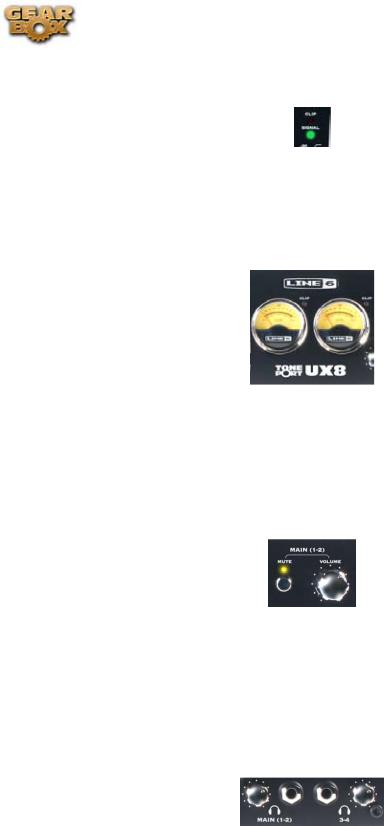
Line 6 GearBox 3.5 – UsingYour Line 6 Hardware
Signal and Clip LEDs
Signal and Clip LEDs exist for each input. The signal LED lights up when signal activity is present, glowing brighter as the signal level increases. When the input level reaches the 0 dBfs, the clip LED lights up momentarily.
VU Meter and Clip Display
The TonePort UX8 provides a stereo pair of large VU meters on the front panel.
By default, these meters display Inputs 1-2 levels. Using the Inputs & Recording Tab of the Line 6 Audio-MIDI Devices application, you can assign the hardware meters to display input and output levels of any stereo pair or GearBox send. The clip LEDs light up when the signal reaches 0 dBfs.
Main Output Level Controls
Main Outputs 1-2 are controlled by a main volume knob and main mute button. The volume knob is an analog level control and does not affect any level being sent to your computer. When Mute is engaged, as solid amber LED illuminates, blinking about once every 2 seconds.
Note that these controls operate on main outputs 1-2 only (headphone and S/PDIF levels are not affected). Outputs 3 – 8 are software controlled.
Headphone Output Controls
Headphone outputs 1-2 and 3-4 provide duplicate stereo outputs or Main Outs 1-2 and 3-4 respectively, providing discrete control over output levels sent over the headphone jacks. Note that headphone output levels are controlled independently of the Main volume control.
2•9
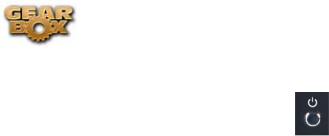
Line 6 GearBox 3.5 – UsingYour Line 6 Hardware
Power Button
When the power button is engaged, the TonePort UX8’s main LEDs will illuminate. TonePort UX8 is not USB powered and receives no power from the computer.
*Note – be sure to always power off or mute your speakers or monitoring setup before connecting and disconnecting the USB cable between TonePort and your computer, powering on/off your TonePort, as well as before booting up or shutting down your computer if TonePort is already connected. The best practice is to always power on your speakers last, and power them off first when connected to other audio gear to avoid a “pop”.
LED status indicators
The Main Mute and Main Clip LEDs provide secondary functions in their ability to indicate the connection status of USB and S/PDIF, as follows:
•No USB connection - The main clip LEDs alternate steadily between left and right, about once every second. The USB cable may be unplugged or the UX8 driver may not be installed on your computer.
•No S/PDIF clock sync - The Mute LED blinks 3 times rapidly about once every second when the clock mode set to S/PDIF, and no external clock is present.
2•10
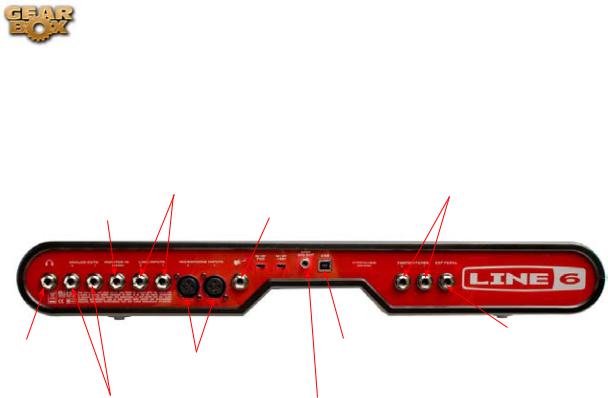
Line 6 GearBox 3.5 – UsingYour Line 6 Hardware
TonePort KB37
Connect |
any |
line |
level input |
source |
for |
monitoring |
to |
the |
Stereo Monitor In
|
Connect up to two standard toggle or |
Connect any line level input |
momentary pedal switches into the |
source that you want to record |
Footswitches jacks for remote control |
into the Line Inputs |
of GearBox and audio application |
Connect your |
electric |
Guitar or Bass |
|
C o n n e c t |
Connect up to two |
Connect your USB cable |
your stereo |
from your computer’s USB |
|
Headphones |
Microphones |
port.* |
Connect an Expression Pedal here for control of MIDI parameters
Connect the Analog Outs |
Connect to the S/PDIF input |
to your audio monitors |
of an external device to send |
|
TonePort’s output digitally |
Microphone Inputs - You can receive input from one or two mics at the same time using these ins. There is also a +48V Phantom Power switch that you should toggle to “on” if your mic requires phantom power (most condenser type mics do, but check the documentation for your mic if you are not sure). Connect each mic using an XLR cable. This inputs each microphone signal independently into GearBox where you can choose your tone, and then route the processed signal both to your audio software and out the TonePort outputs.
Guitar/Bass Input -To connect your electric guitar or bass, plug it into this input. This connection routes the instrument’s signal into GearBox where you can choose your tone and route the processed signal both to your audio software and out the TonePort outputs. This input also features a Pad switch; engage this switch when using a guitar/bass with high-output or active pickups, to avoid overdriving the input.
Headphones - If you want to listen to the audio from TonePort using stereo headphones, then plug them into this 1/4-inch stereo jack. This Headphone jack outputs the same signal fed to the Analog Outs on the rear panel of TonePort; the audio from your audio software on the computer, as well as anything plugged into any TonePort input.
*Note – be sure to always power off or mute your speakers or monitoring setup before connecting and disconnecting the USB cable between TonePort and your computer, as well as before booting up or shutting down your computer if TonePort is already connected. The best practice is to always power on your speakers last, and power them off first when connected to other audio gear to avoid a “pop”.
Line Inputs - if you want to record the signal from a line level source, such as a keyboard, your stereo receiver, the line out from a mixing console, etc., connect them to these Left and Right ins using 1/4- inch TS audio cables.
2•11

Line 6 GearBox 3.5 – UsingYour Line 6 Hardware
Footswitches - if you want to use one or two on/off toggle or momentary footswitches to remotely control functions in the GearBox software, you can plug the 1/4-inch footswitch plugs into these 1 and 2 jacks. To configure each Footswitch, go to the GearBox Preferences. You can also use these footswitches to trigger recording and playback commands within the included Ableton Live Lite 5 software!
Expression Pedal - Connect a 1/4-inch TS expression pedal to control Volume, Wah or any other MIDI CC parameter in GearBox or your recording application. To configure the expression pedal, go to the GearBox preferences .
USB - This of course is where you connect the supplied USB cable to TonePort, with the other end going to your computer’s USB port. Note that you should always connect to a separate USB controller channel from other USB audio or MIDI interfaces to provide TonePort with the full USB bandwidth. TonePort also gets its power from this USB connection, so it should not be plugged into a non-powered USB hub, or operated on the same USB controller channel with un-powered devices. It is also recommended to connect directly into a USB port on your computer and not into a USB hub.
S/PDIF Digital Out - To send the output of TonePort to an external device digitally, connect a 75Ohm coaxial cable into this RCA jack and then into the S/PDIF digital input on the external device. This is the best choice for connecting to digital recording devices, such as a DAT recorder. This S/ PDIF output sends the same audio as is sent to TonePort’s Analog Outs* (with the exception that any audio coming into the TonePort’s Monitor In jack is not routed to the S/PDIF output). The digital signal is always sent at 24-bit resolution.
*Note that when using TonePort KB37 with GearBox, the GuitarPort Player playback audio is never routed to this S/PDIF output. This is necessary to comply with artist copyright requirements that Line 6 follows for the GuitarPort Online Tracks and artist content.
Monitor In - If you want to hear the signal from a line level source mixed with all the other audio coming from your computer, but do not want this audio recorded, then plug the source in here. Note that this is a stereo jack, so you should use a stereo 1/4-inch TRS audio cable for this connection.
Analog Outs - These Left and Right balanced jacks output all the audio from TonePort; the audio from your audio software on the computer, and anything plugged into any TonePort input. So, these are what you want to connect to your monitoring system when using TonePort as your computer’s sound card. Use either 1/4-inch TS or TRS cables to connect directly to your powered speakers, mixer or power amp setup. Note that you can also use the headphone jack on the front of TonePort if you want to use headphones for monitoring.
2•12
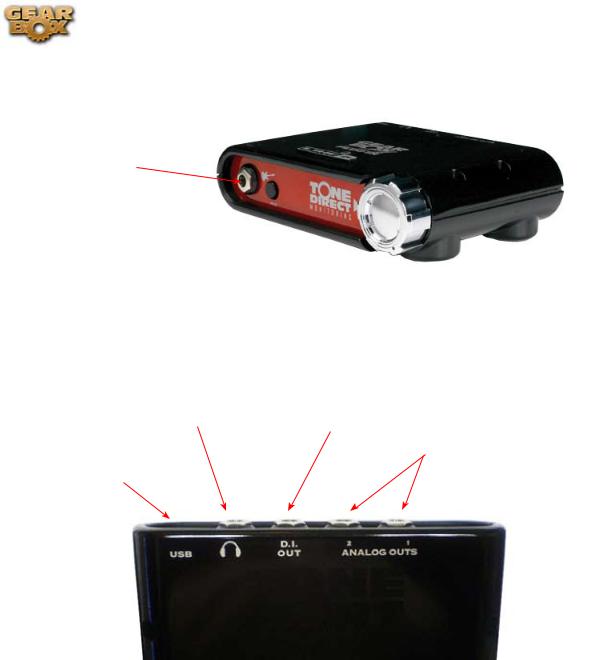
Line 6 GearBox 3.5 – UsingYour Line 6 Hardware
TonePort DI
Connect your electric Guitar or Bass
Guitar/Bass - To input your electric guitar or bass, plug it in here using a standard 1/4-inch TS instrument cable. This input also features a Pad switch; engage this switch when using a guitar/bass with high-output or active pickups, to avoid overdriving the input.
Connect your stereo
Headphones
Connect a USB cable from here to your computer
Connect to your 3rd-party audio interface for recording with GearBox plug-in
Analog Line Outs – connect to your powered speakers or mixer
USB - This of course is where you connect the supplied USB cable to TonePort, with the other end going to your computer’s USB port. Note that you should always connect to a separate USB controller channel from other USB audio or MIDI interfaces to provide TonePort with the full USB bandwidth. TonePort also gets its power from this USB connection, so it should not be plugged into a non-powered USB hub, or operated on the same USB controller channel with un-powered devices. It is also recommended to connect directly into a USB port on your computer and not into a USB hub.
Phones - If you want to listen to the audio from TonePort using stereo headphones, then plug them into this 1/4-inch stereo jack. This headphone jack outputs the same signal fed to the Analog Outs on the rear panel of TonePort; the audio from your audio software on the computer, as well as anything plugged into any TonePort input.
D.I Out - This connection lets you record an unprocessed signal to your track, to which you can apply the GearBox plug-in. If you use a 3rd-party audio interface, connect the D.I. to one of its inputs, and route that input to the track you’re recording into.
2•13

Line 6 GearBox 3.5 – UsingYour Line 6 Hardware
Analog Outputs - When using TonePort DI as an audio interface for your recording application, these outputs carry the Master stereo mix from your recording project. If you ‘re using a 3rd-party Audio Interface, these outputs supply the ToneDirect™ magic to your interface or mixer, when using the GearBox application alongside the plug-in. See the ToneDirect™ Monitoring section for more details.
2•14
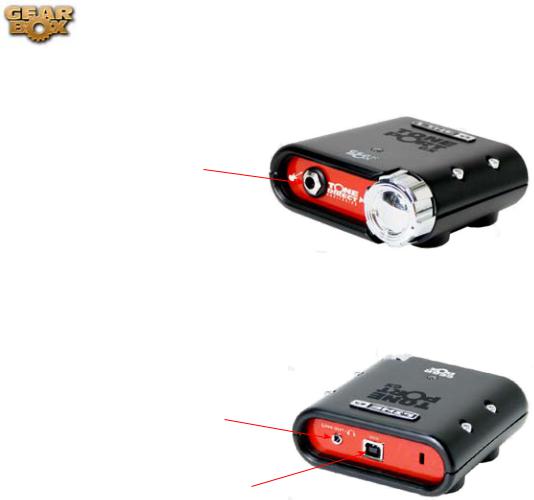
Line 6 GearBox 3.5 – UsingYour Line 6 Hardware
TonePort GX
Connect your electric Guitar or Bass
Guitar/Bass - To input your electric guitar or bass, plug it in here using a standard 1/4-inch TS instrument cable.
Connect your stereo
Headphones/Line Out Cable
Connect USB cable from here to your computer
USB - This of course is where you connect the supplied USB cable to TonePort GX, with the other end going to your computer’s USB port. Note that you should always connect to a separate USB controller channel from other USB audio or MIDI interfaces to provide TonePort GX with the full USB bandwidth. TonePort GX also gets its power from this USB connection, so it should not be plugged into a non-powered USB hub, or operated on the same USB controller channel with unpowered devices. It is also recommended to connect directly into a USB port on your computer and not into a USB hub.
Line Out/Phones - When connecting TonePort GX as an audio interface for your recording application, this output carries the Master stereo mix from your recording project. If you ‘re using a 3rd-party Audio Interface, these outputs supply the ToneDirect™ magic to your interface or mixer, when using the GearBox application alongside the plug-in. See the ToneDirect™ Monitoring section for more details.
If you want to listen to the audio directly from TonePort GX using stereo headphones, you can also plug them into this 1/8-inch stereo jack. This line out/headphone jack outputs the same signal fed to the Analog Outs on the rear panel of TonePort; the audio from your audio software on the computer, as well as anything plugged into any TonePort input.
2•15
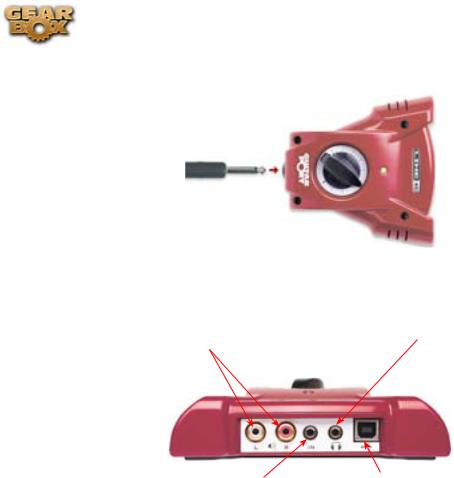
Line 6 GearBox 3.5 – UsingYour Line 6 Hardware
GuitarPort
Instrument input - your electric guitar or bass, plug it into this input using a standard 1/4-inch TS instrument cable. This inputs the signal into GearBox where you can choose your Tone and route the processed signal both to your audio software and out the GuitarPort outputs.
Analog Line Outs – connect to your |
Connect your stereo headphones |
powered speakers or mixer |
|
Monitor In – connect a line level, stereo output (from your stereo, MP3 player, etc).
Connect USB cable from here to your computer
Analog Line Outs - These Left and Right RCA jacks output all audio signals; the audio from your audio software on the computer, and anything plugged into any the Instrument or Monitor inputs. So, these are what you want to connect to your monitoring system when using GuitarPort as your computer’s sound card. Use sheilded RCA to RCA tipped cables to connect directly to your powered speakers, mixer or power amp setup. Note that you can also use the headphone jack on GuitarPort if you want to use headphones for monitoring.
Headphones - If you want to listen to the audio using stereo headphones, then plug them into this 1/8-inch stereo jack. This Headphone jack outputs the same signal fed to the Analog Line Outs; the audio from your audio software on the computer, as well as anything plugged into the Instrument or Line inputs.
Monitor In - If you want to hear the signal from a line level source mixed with all the other audio coming from your computer, but do not want this audio recorded, then plug the source in here. Note that this is a stereo jack, so you should use a stereo 1/8-inch tipped stereo audio cable for this connection. You’ll hear any audio coming into this jack via the Analog Line Outs and Phones, but it won’t go to GuitarPort’s Record Send 1-2.
USB - This is where you connect the supplied USB cable to GuitarPort, with the other end going to your computer’s USB port. Note that you should always connect to a separate USB controller channel from other USB audio or MIDI interfaces to provide GuitarPort with the full USB bandwidth. GuitarPort also gets its power from this USB connection, so it should not be plugged into a nonpowered USB hub, or operated on the same USB controller channel with un-powered devices. It is also recommended to connect directly into a USB port on your computer and not into a USB hub.
2•16
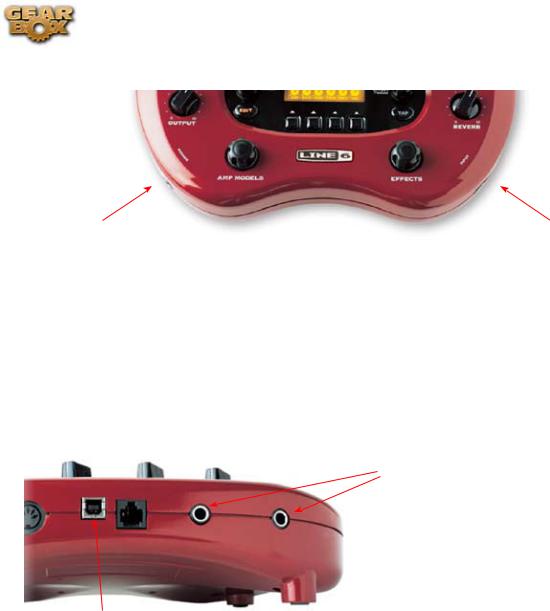
Line 6 GearBox 3.5 – UsingYour Line 6 Hardware
PODxt
Phones - Connect your |
Instrument Input - Connect |
stereo Headphones |
your guitar or bass |
Instrument input – Connect your electric guitar or bass here using a standard 1/4-inch TS instrument cable. PODxt itself contains the processing power that turns your naked input signal into that roaring guitar Tone, which is then fed out the Analog Line Outs, as well as fed to the Record Send 1-2 digitally to your computer across the USB connection. When you are connected via USB to your computer, you can also launch GearBox and use it to alternatively load Tones stored on your hard disc, edit them on your screen, and make adjustments for output and Record Send levels.
Phones - If you want to listen to the audio using stereo headphones, then plug them into this 1/4-inch stereo jack. This Headphone jack outputs the same signal fed to the Analog Line Outs; the audio from your audio software on the computer, as well as anything plugged into the Instrument input.
Analog Line Outs – connect to your powered speakers or mixer
USB - Connect to your computer
Analog Line Outs - These Left and Right ¼-inch jacks output all audio signals; the audio from your audio software on the computer, and anything plugged into any the Instrument input. So, these are what you want to connect to your monitoring system when using PODxt as your computer’s sound card. Use shielded ¼-inch tipped cables to connect directly to your powered speakers, mixer or power amp setup. Note that you can also use the Phones jack on PODxt if you want to use headphones for monitoring.
USB - This is where you connect the supplied USB cable to PODxt, with the other end going to your computer’s USB port. Of course your PODxt is capable of processing your guitar Tone all by itself, but you’ll need to connect the USB cable to your computer to use it with GearBox, and to use PODxt as your sound card device. Note that you should always connect to a separate USB controller channel from other USB audio or MIDI interfaces to provide PODxt with the full USB bandwidth. It is also recommended to connect directly into a USB port on your computer and not into a USB hub.
2•17
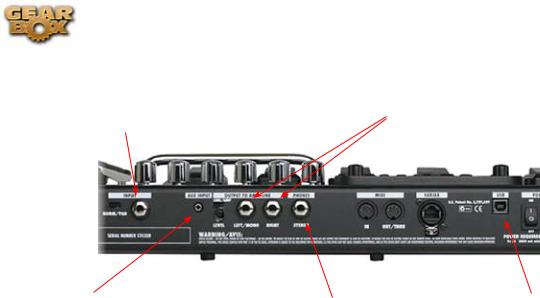
|
Line 6 GearBox 3.5 – UsingYour Line 6 Hardware |
PODxt Live |
|
Instrument Input - Connect |
Analog Line Outs – connect to |
your guitar or bass |
your powered speakers or mixer |
Aux Input – (Monitor in) |
Phones - Connect your |
USB - Connect to |
connect a line level, stereo |
stereo Headphones |
your computer |
output (from your stereo, MP3 |
|
|
player, etc) |
|
|
Instrument input – Connect your electric guitar or bass here using a standard 1/4-inch TS instrument cable. PODxt Live itself contains the processing power that turns your naked input signal into that roaring guitar Tone, which is then fed out the Analog Line Outs, as well as fed to the Record Send 1-2 digitally to your computer across the USB connection. When you are connected via USB to your computer, you can also launch GearBox and use it to alternatively load Tones stored on your hard disc, edit them on your screen, and make adjustments for output and Record Send levels.
Analog Line Outs - These Left and Right ¼-inch jacks output all audio signals; the audio from your audio software on the computer, and anything plugged into any the Instrument and Aux inputs. So, these are what you want to connect to your monitoring system when using PODxt Live as your computer’s sound card. Use shielded ¼-inch tipped cables to connect directly to your powered speakers, mixer or power amp setup. Note that you can also use the Phones jack on PODxt Live if you want to use headphones for monitoring.
Aux In (Monitor In) - If you want to hear the signal from a line level source mixed with all the other audio coming from your computer, but do not want this audio recorded, then plug the source in here. Note that this is a stereo jack, so you should use a stereo 1/8-inch tipped stereo audio cable for this connection. You’ll hear any audio coming into this jack via the Analog Line Outs and Phones, but it won’t go to PODxt Live’s Record Send 1-2.
Phones - If you want to listen to the audio using stereo headphones, then plug them into this 1/4-inch stereo jack. This Headphone jack outputs the same signal fed to the Analog Line Outs; the audio from your audio software on the computer, as well as anything plugged into the Instrument and Aux inputs.
USB - This is where you connect the supplied USB cable to PODxt Live, with the other end going to your computer’s USB port. Of course your PODxt Live is capable of processing your guitar Tone all by itself, but you’ll need to connect the USB cable to your computer to use it with GearBox, and to use PODxt Live as your sound card device. Note that you should always connect to a separate USB controller channel from other USB audio or MIDI interfaces to provide PODxt Live with the full USB bandwidth. It is also recommended to connect directly into a USB port on your computer and not into a USB hub.
2•18
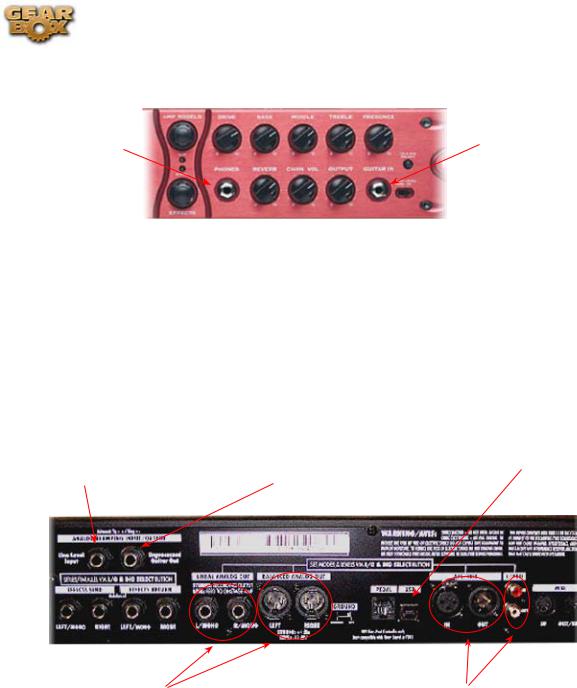
|
Line 6 GearBox 3.5 – UsingYour Line 6 Hardware |
PODxt PRO |
|
Phones-Connectyour |
Instrument Input - Connect |
stereo Headphones |
your guitar or bass |
Instrument input – Connect your electric guitar or bass here using a standard 1/4-inch TS instrument cable. PODxt Pro itself contains the processing power that turns your naked input signal into that roaring guitar Tone, which is then fed out the Analog and Digital Outs, as well as fed to the Record Send 1-2 digitally to your computer across the USB connection. When you are connected via USB to your computer, you can also launch GearBox and use it to alternatively load Tones stored on your hard disc, edit them on your screen, and make adjustments for output and Record Send levels.
Phones - If you want to listen to the audio using stereo headphones, then plug them into this 1/4-inch stereo jack. This Headphone jack outputs the same signal fed to the Analog Line Outs; the audio from your audio software on the computer, as well as anything plugged into the Instrument input.
Connect any Line-Level source you want to record to the Line Input
Unprocessed Instrument OutWhen |
USB - Connect to |
using GearBox Plug-in, connect to 3rd- |
your computer |
party audio recording interface |
|
Analog Line Outs, Use either Unbalanced (¼ -inch) jacks or Balanced (XLR) jacks to connect to your powered speakers or mixer
Digital Input and Output – use the AES/EBU or S/PDIF type connections to connect to other digital gear that uses one of these formats
Line Input - if you want to record the signal from a line level source, such as a keyboard, your receiver, the line out from a mixing console, etc…, connect it to this input using a 1/4-inch TS audio cable.
Unprocessed Guitar Out - This connection allows you to send an unprocessed signal to your recording application, while monitoring the fully processed signal thru the main Outputs. Very handy if you’re using a 3rd party recording interface with your recording application and the GearBox plug-in. For more info, go to the ToneDirect™ Monitoring section of this Guide.
Note: Your PODxt Pro can also send an unprocessed signal thru its USB connector, as explained here.
2•19

Line 6 GearBox 3.5 – UsingYour Line 6 Hardware
Unbalanced and Balanced Analog Line Outs - The Left and Right Unbalanced ¼-inch jacks and the Balanced XLR jacks output all audio signals; the audio from your audio software on the computer, and anything plugged into any the Instrument inputs (and effects loop, if you are using it). So, these are what you want to connect to your monitoring system when using PODxt Live as your computer’s sound card. Use shielded ¼-inch tipped or XLR tipped cables to connect directly to your powered speakers, mixer or power amp setup. Note that you can also use the Phones jack on PODxt Pro if you want to use headphones for monitoring.
USB - This is where you connect the supplied USB cable to PODxt Pro, with the other end going to your computer’s USB port. Of course your PODxt Pro is capable of processing your guitar Tone all by itself, but you’ll need to connect the USB cable to your computer to use it with GearBox, and to use PODxt Pro as your sound card device. Note that you should always connect to a separate USB controller channel from other USB audio or MIDI interfaces to provide PODxt Pro with the full USB bandwidth. It is also recommended to connect directly into a USB port on your computer and not into a USB hub.
AES/EBU and S/PDIF Digital connections - To connect to another digital audio device with your PODxt Pro, use the pair of these digital jacks that matches the format of your other device (AES/EBU or S/PDIF). Connecting digitally is the best choice for routing to external digital recording devices, such as a DAT recorder. These digital outputs send the same audio as is sent to PODxt Pro’s Analog Outs.* The digital signal is always sent at 24-bit resolution. All settings for configuring the PODxt Pro’s digital in/out options are found on the PODxt Pro device itself by pressing the “I/O Dig Select” button on the front panel (these digital I/O options are not accessible in GearBox). For more information on using these digital connections, please see your PODxt Pro Pilot’s Handbook.
2•20

Line 6 GearBox 3.5 – UsingYour Line 6 Hardware
PODxt - Audio Signal Routing & Re-Amping
Re-Amping is the fancy schmancy name for recording a dry, unaltered instrument signal to be processed later during mixing - this gives you the greatest flexibility to make later tone tweaks, since you don’t have to commit a particular sound to the track(s). This is of course the way that plug-ins work, so it’s something that all plug-ins, including GearBox Plug-in, provide. If you don’t have plug-ins but do have PODxt, there’s another kind of re-amping available.
PODxt, PODxt Pro* and PODxt Live provide an additional set of driver options for recording where the signal fed to Record Send 1-2 can be set to “processed” or “unprocessed” independently from what you are hearing as your monitor signal from the PODxt device. Access the PODxt Audio Signal Routing options by clicking the Advanced button in the Line 6 Audio-MIDI Devices control panel...
Select the signal to be routed to the Record Sends here. 
The text in the Record Sends panel describes the signal now being carried on he Record Sends
This slider sets the level of the re-amped signal sent to PODxt for monitoring
In the PODxt Signal Routing selector you can choose one of four routing modes for the signals that run inside PODxt, and to Record Send 1-2:
•Send Processed Guitar - This is the normal mode of operation: PODxt-processed sound is sent to your computer via Record Send 1-2 so it can be recorded in your audio software. PODxt gets its input from the guitar plugged into its INPUT jack, and you can listen to PODxt-processed guitar sound as well as sound coming from your computer via PODxt’s LEFT OUTPUT, RIGHT OUTPUT and PHONES jacks.
•Send Clean Guitar - This mode sends unprocessed guitar to your to Record Send 1-2, while you listen to PODxt-processed guitar and software playback coming out of your PODxt. You can use this to record an unprocessed guitar signal in your audio software for later re-amping, while hearing your PODxt-processed guitar signal without latency being added by your recording program. You can then choose USB Signal Routing modes 3 and 4 when you’re ready to playback that track and re-amp it through your PODxt. You may also want to record a copy of your PODxt-processed sound from the analog outputs of your PODxt when you are making your digital recording of the clean guitar, so you have the processed version for reference when re-amping. This track is also handy for punch-ins, since you can listen to it during punch-ins to hear the processed version of the part of the previously recorded track that you want to keep.
•Send Clean Guitar Re-Amp Playback - This mode sends un-processed guitar to your recording software, feeds the signal from your computer into PODxt’s processing, and lets you hear the PODxt-processed computer sound at PODxt’s outputs. You can use this to run an unprocessed guitar track that you recorded using USB Signal Routing mode 2 into your PODxt for re-amping,
2•21
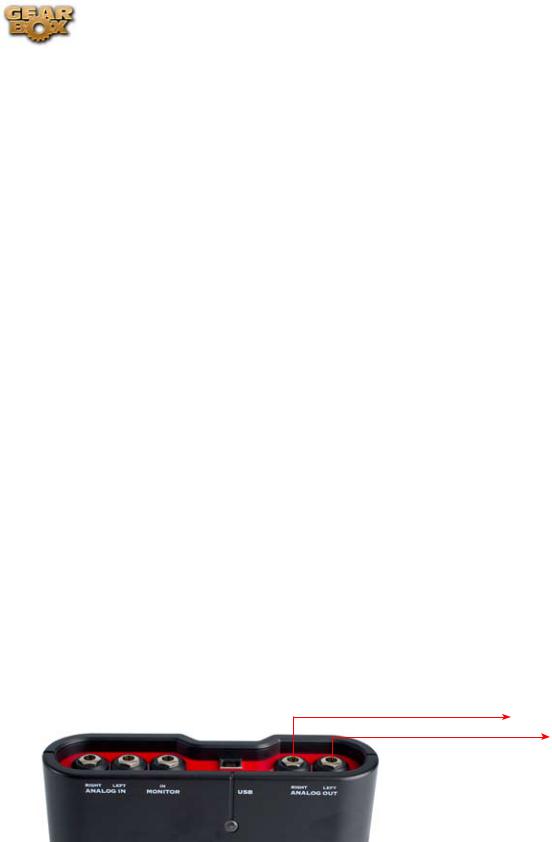
Line 6 GearBox 3.5 – UsingYour Line 6 Hardware
allowing you to listen to or record the PODxt-processed result via PODxt’s analog outputs. You can also use this mode during initial recording, so that unprocessed guitar can be recorded to a track, and the output of that track can be sent by the recording program to PODxt at the same time. This lets you punch-in on the track while you’re recording, and hear PODxt processing of the already recorded part of the track as well as the new portion that you’re recording during the punch-in. Your recording software will add some latency to the guitar signal that it is monitoring back through to PODxt. You can generally get the lowest latency by reducing your buffer size in the recording software, but lower buffer settings will utilize more of your computer’s processing, so you may not be able to run as many tracks or effects in your recording software when you do this. See your recording software’s instructions for details.
•Send Re-Amp Playback - This mode is designed to receive unprocessed guitar from your recording program, and send processed guitar back to the recording program for recording. You can use this to run an unprocessed guitar track that you recorded using USB Signal Routing mode 2 into your PODxt for re-amping, so you can digitally record the PODxt-processed signal back to another track in the recording program.
Note – it is not a supported practice to “hot swap” your Line 6 device (unplug the USB cable and plug it into a different USB device) while it is in use by GearBox or any other audio software. In fact, this just isn’t a good idea to do with any USB audio devices, since it can result in a loud pop, loss of sync
and possibly crash or corrupt your current audio software project.
Routing audio from your Line 6 hardware to an external device
In addition to the ability to route digital audio directly within your computer, you may instead want to route your GearBox or PODxt signal into another sound card on the same or separate computer. Better yet, with all the great tones you can now create for your mics & instruments with GearBox, there is no need to limit them to the inside of a computer! You may also want to send the signal to external hardware such as an analog or tape Multitrack unit, a DAT or video tape recorder, or even to an amplifier or P.A. system for live performance. To follow are instructions for these different types of setups.
Connecting analog outputs to an external device
You can route your GearBox Tone to just about any type of external device simply by connecting the Analog Outs from the back of your GuitarPort, TonePort or PODxt directly into the external device’s line level inputs. This allows you to amplify or record your GearBox signal using any external device that accepts analog line level inputs.
Connect your TonePort, GuitarPort or PODxt Analog Outs to the analog inputs on any external audio device
2•22
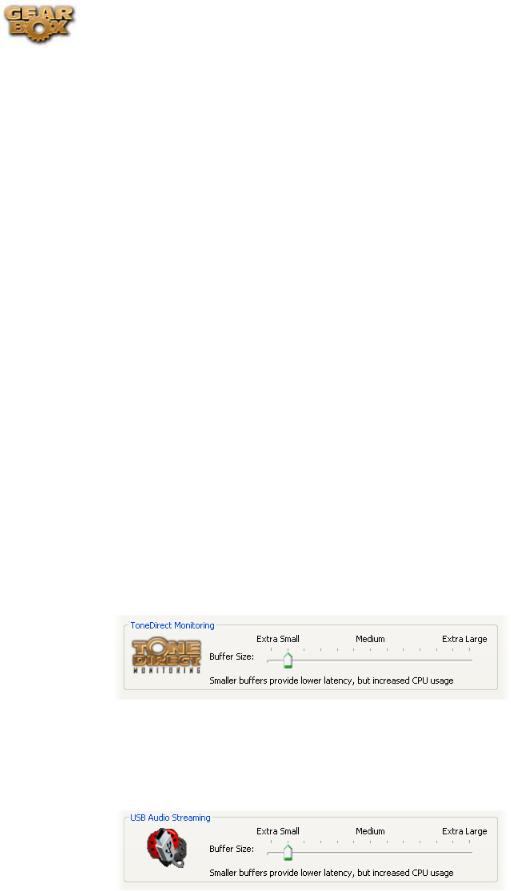
Line 6 GearBox 3.5 – UsingYour Line 6 Hardware
Routing analog outputs to another sound card
If you want to use GearBox and your Line 6 device in a computer recording setup where a sound card already exists, then you might find it useful to connect your Analog Outs into the analog inputs of the existing sound card. More information can be found in the Sound Card and Sound Issues section of this guide.
Connecting the Digital Output from TonePort UX2, UX8, KB37 or PODxt Pro to an external digital device
TonePort UX2, UX8, KB37 and PODxt Pro also include digital outputs, which allow you to connect to digital devices such as a DAT recorder, Minidisk, another sound card, or most any device that offers a S/PDIF (or AES/EBU for PODxt Pro) format digital input. Please refer to your hardware’s User Guide for more information.
ToneDirect™ Monitoring
A unique feature of your Line 6 hardware is ToneDirect™ Monitoring, which is a separate audio path that allows you to monitor the incoming signal with the lowest possible latency, for uncompromised feel and responsiveness when recording or jamming.
Plus, this lets you to set the audio buffer size in your recording application at a large value for efficient use of your computer, yet still enjoy extreme low latency monitoring while recording. On Windows systems, the ToneDirect™ audio path has its own buffer adjustment while on Mac, no adjustments are needed.
ToneDirect™ Monitoring buffer size slider (Windows®)
TonePort & GuitarPort devices The Line 6 ToneDirect™ Monitoring audio path has its own buffer to allow you to keep your ASIO Buffer Size at a high value, for more solid performance and more efficient performance of your ASIO software. The initial default is one tick to the right of “Extra Small” as shown. Raise this slider if you are getting any dropouts in your monitor signal.
PODxt devices utilize a USB audio buffer (rather than ToneDirect™ Monitoring) which provides an independent, direct monitor signal with its own buffer adjustment. When a PODxt/Live/Pro is selected as the Line 6 device in this dialog, the ToneDirect™ Monitoring section of the dialog is replaced by a PODxt-specific “USB Audio Streaming” buffer slider:
2•23
